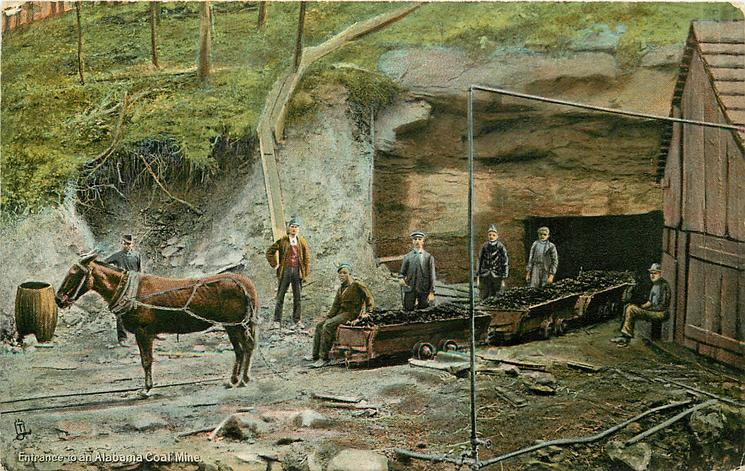Alabama Mines and Mining
The following excerpt from Memorial record of Alabama
by Brint Fuller, 1893
The mineral region, par excellence, of Alabama, embracing fully one-third of the territorial area of the state, is so called on account of the variety and abundance of the leading minerals of commerce to be found therein, and the fact that nearly all, if not all, the mines which are now worked, by common consent, constitute the mineral belt. But this area, rich and prolific as it is, does not monopolize all the mineral wealth of Alabama. In several of the counties of the Tennessee valley, in portions of the “cotton belt,” and also in the far south, called the “timber belt,” minerals have been found in more or less profusion.
Lauderdale county contains iron; iron, coal and lead and silver have been found in Limestone county; coal and iron in Jackson; coal, manganese, copper, lead and silver in Marshall; coal in Morgan (also asphalt, the first trace discovered in Alabama ; coal in Lawrence; traces of iron, coal and lead in Pickens; traces of iron and mineral springs and wells in Sumter; traces of petroleum and mineral springs in Choctaw; kaolin and other minerals in Perry and Barbour counties; traces of iron in Washington; mineral and salt wells, and gypsum in Clarke; traces of iron and very strong mineral springs near Greenville and in the northern part of Butler; and iron ore has been found in considerable quantities in the northern part of the county of Mobile.
The first attempt to manufacture iron, in Alabama, was made in Franklin county in the year 1818, but, as Dr. Riley informs us, after an experience of nine years, the enterprise was abandoned.
Gold and silver have been mined to a limited extent. Dr. Phillips, in bulletin No. 3 of the state geological survey (1892), expresses the opinion that gold was first discovered in Alabama about the year 1830, and states that, shortly afterward, the placers and gravel washes became the seats of an active industry in the counties of Cleburne, Talladega, Randolph, Tallaposa, Coosa, Chilton, and perhaps, also of Clay. No record of these operations has been preserved; all that is now known is that large numbers of men were engaged in the work and that in some places, at least, it was found profitable.
Mr. Phillips, from a personal examination of this gold-bearing region, has come to the conclusion that gold mining could be carried on very successfully, if the enterprise was judiciously undertaken and prudently and diligently prosecuted. To the geological survey of the state belongs the credit and honor of revealing the untold riches which lie beneath the soil of Alabama; of testing the quality and approximating the value of its mineral treasures; suggesting methods through which they can be most profitably worked, and furnishing the accurate information which has led to their marvelous developement and made the mineral wealth of Alabama a household word in the marts of commerce and in the monetary centers of the United States and Europe. The first systematic geological exploration of the state was inaugurated by Professor Michael Toumey, of the university of Alabama, on the 13th of July, 1848. Individual papers upon the geology of the state had previously been made and were published in Silliman’s Journal, by Conrad, Lea, Shepherd, Martin and others, and in 1838, Professor R. T. Brumley, of the state university, published a short sketch of the geology of the state. In 1846, that eminent geologist, Sir Charles Lyell, visited Alabama and made a brief investigation of the geological features of the state, and the results of his explorations were given to the public in the journal of the “Geological Society of England,” and in “Lyell’s Second Visit to the United States.” In January, 1848, Professor Toumey was appointed state geologist and entered actively upon the work of exploration. A report of his work during the succeeding two years, entitled, “First Biennial Report of the Geology of Alabama,” was printed in Tuscaloosa in 1850 and attracted wide attention. He continued work on the state geological survey until the autumn of 1856, when he resumed the duties of his professorship at the university of Alabama. He was taken ill in February, 1857, went to Mobile for treatment, and died there, March 3, 1857—honored and lamented by the people of Alabama, for whom he had done so much, and by scholars and Scientists throughout the country. He laid the foundation for the wonderful development. of the mineral resources of Alabama which, under the diligent explorations and eminently practical counsels of Dr. Eugene A. Smith, the present head of the geological survey, and his coadjutors, has elevated her to the very front rank among mineral producing states. In the further discussion of “Mines and Mining” in Alabama, it is proposed to consider principally the great leading industries of iron and coal; first, however, glancing briefly at the discoveries and developments made in gold, silver, copper, lead and tin.
